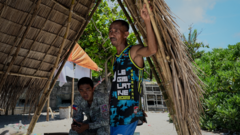In the sprawling South China Sea, the small island of Pagasa, known as "hope," represents a beacon of defiance for the Philippines against China's aggressive territorial claims. Stretching just 37 hectares, Pagasa is home to around 300 residents who live in modest wooden homes, fishing in the rich turquoise waters and cultivating sparse gardens among sand.
However, an uneasy presence looms slightly offshore: a fleet of Chinese vessels, including navy ships, coastguard units, and maritime militia, actively patrol the waters claiming dominion over them. For over a decade, China has intensified its grip, establishing air bases on submerged reefs and deploying an extensive fleet to solidify their extensive claims over these waters, which are critical for trade routes.
Unlike other Southeast Asian nations that also stake claims, only the Philippines and Vietnam have increasingly taken a stand against China, bolstered by their assertions of rightful ownership over certain islands and reefs. Pagasa Island, known by other names including Thitu, is notable for its civilian population, enabling the Philippines to strengthen its legal case to maintain control.
Jonathan Malaya, a senior official from the National Security Council, emphasizes the significance of Pagasa, citing its sturdy land and human settlement as integral to the Philippines' territorial rights. The island's runway, enhanced two years ago, can now accommodate larger aircraft like C130 transports, allowing for better supply deliveries amid frequent unpredictable weather events.
Life on Pagasa is heavily reliant on supplies shipped from the mainland, making logistics a constant challenge. The community receives monthly aid, and advancements such as electricity and mobile connectivity have only been established in recent years. With fishing as the primary livelihood, increasing Chinese incursions have threatened local fish stocks, forcing residents like fisherman Larry Hugo to curtail their traditional fishing activities and stay closer to the island for safety.
The island also benefits from educational progress, having developed its schooling facilities under the care of dedicated teachers like Realyn Limbo. While she highlights the island's serene charms, she notes the challenges faced in health emergencies, where residents sometimes struggle for timely evacuation to the mainland when situations escalate.
Nevertheless, self-sufficiency is difficult to maintain in such isolation, prompting many young residents to depart once educational opportunities conclude. The island, charming with its tranquility and expansive beaches, retains an air of vigilance as a fortified outpost amidst constant Chinese maritime presence.
Despite the throes of geopolitical contention, Pagasa’s community remains resolute. Frequent diplomatic protests by the Philippine government underscore the shift in approach from previous administrations, signifying an unwavering commitment to uphold sovereignty rights. The tension of navigating claims and challenges continues to define life on Pagasa Island, representing both a sanctuary of hope and a frontline in the complex maritime landscape.






















